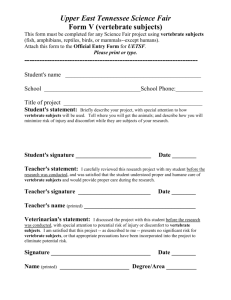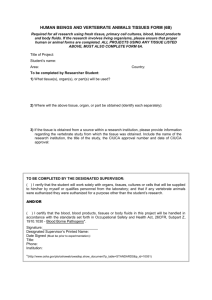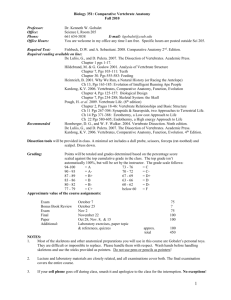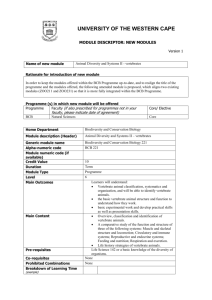Biology 351: Vertebrate Morphology
advertisement
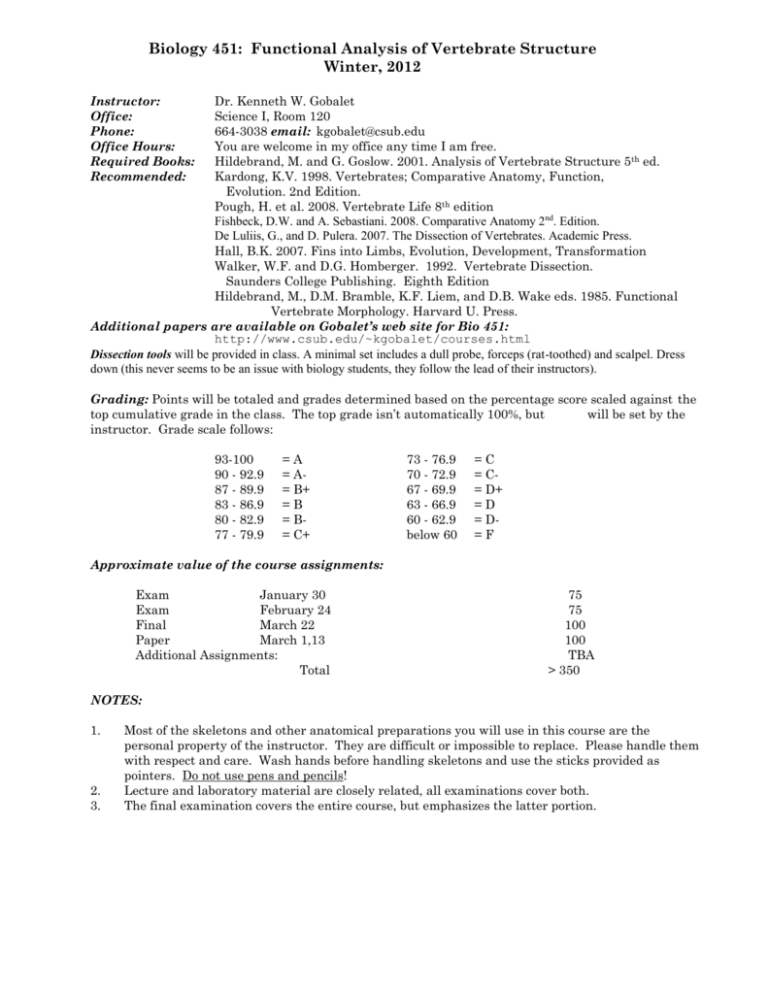
Biology 451: Functional Analysis of Vertebrate Structure Winter, 2012 Instructor: Office: Phone: Office Hours: Required Books: Recommended: Dr. Kenneth W. Gobalet Science I, Room 120 664-3038 email: kgobalet@csub.edu You are welcome in my office any time I am free. Hildebrand, M. and G. Goslow. 2001. Analysis of Vertebrate Structure 5th ed. Kardong, K.V. 1998. Vertebrates; Comparative Anatomy, Function, Evolution. 2nd Edition. Pough, H. et al. 2008. Vertebrate Life 8th edition Fishbeck, D.W. and A. Sebastiani. 2008. Comparative Anatomy 2nd. Edition. De Luliis, G., and D. Pulera. 2007. The Dissection of Vertebrates. Academic Press. Hall, B.K. 2007. Fins into Limbs, Evolution, Development, Transformation Walker, W.F. and D.G. Homberger. 1992. Vertebrate Dissection. Saunders College Publishing. Eighth Edition Hildebrand, M., D.M. Bramble, K.F. Liem, and D.B. Wake eds. 1985. Functional Vertebrate Morphology. Harvard U. Press. Additional papers are available on Gobalet’s web site for Bio 451: http://www.csub.edu/~kgobalet/courses.html Dissection tools will be provided in class. A minimal set includes a dull probe, forceps (rat-toothed) and scalpel. Dress down (this never seems to be an issue with biology students, they follow the lead of their instructors). Grading: Points will be totaled and grades determined based on the percentage score scaled against the top cumulative grade in the class. The top grade isn’t automatically 100%, but will be set by the instructor. Grade scale follows: 93-100 90 - 92.9 87 - 89.9 83 - 86.9 80 - 82.9 77 - 79.9 =A = A= B+ =B = B= C+ 73 - 76.9 70 - 72.9 67 - 69.9 63 - 66.9 60 - 62.9 below 60 =C = C= D+ =D = D=F Approximate value of the course assignments: Exam January 30 Exam February 24 Final March 22 Paper March 1,13 Additional Assignments: Total 75 75 100 100 TBA > 350 NOTES: 1. 2. 3. Most of the skeletons and other anatomical preparations you will use in this course are the personal property of the instructor. They are difficult or impossible to replace. Please handle them with respect and care. Wash hands before handling skeletons and use the sticks provided as pointers. Do not use pens and pencils! Lecture and laboratory material are closely related, all examinations cover both. The final examination covers the entire course, but emphasizes the latter portion. Schedule Biology 451 Winter 2012 Week Topic Readings Laboratory Hildebrand & Goslow (H&G) _______________________________________ _______________________________ Jan 9-13; 17-20 Vertebrate Diversity H&G 2-4. 8, 9 Vertebrate diversity & skeleton Pough etal (2009) Ch2 Student paper summaries & Ch 11, De Lullis 2007 Jan 23-27 H&G 21, 22, 23 Kardong 2006: Ch 4 Biomechanics of ulna Biomechanics problems H&G 7, 30 Biomechanics problems Fish Skull exercise Structural Elements Biological Design Jan 30- Feb 3 Teeth, Feeding Jan 31 Exam Feb 6-10 Size considerations Feb 7 Topic due H&G 21, 22, 23 Mammal Skull exercise Sander & Clauss (2008) Bird flight muscle Freedman and Noakes (2003) Feb 13-17 Running & Jumping H&G 24 Bone as a spring Hall 19 (Vickaryous & Olson 2007) Bramble and Lieberman (2004) Sesamoids & menisci Feb 20-24 Digging, Crawling Climbing Feb 24 Exam H&G 25, 26 Chicken feet Hall Cptr 17 (Kley & Kearney 2007)) Feb 27-Mar 1 Swimming and Diving H&G 27 Fish (snakehead) head March 1 paper due (peer review) Hall Cptr 18 (Thewissen & Taylor 2007) March 5-9 Flying and Gliding H&G 28 Cat claws or Weberian ossicles Hall Cptr 16 (Gatesy & Middleton 2007) Student oral presentations March 12-16 Energetics March 13: Paper due H&G 29 Beef hoof Carrier (1987) Student oral presentations Carey (1971) Pough 2009 Ch 14, 22 March 22 Final 11:00-1:30 Possible options Shark brain Femur scaling Dissection of mammalian ear ossicles PROJECT / PAPER Important Dates: Feb 7 Topic statement (paragraph), including a proper alphabetical citation list of 8 references. Mar 1 “Polished” copy due for in class peer review. Mar 13 Revised copy due with marked peer evaluated copies(s). Mar 9, 13,15. Student oral presentation of projects Assignment: Each student is required to submit a paper dealing with some aspect of vertebrate biology that includes a significant morphological component. The target audience is other students in the class. A project that includes original or illustrative work is to be written-up following the format found in “How to Write a Scientific Research Report.” This paper shall have a minimum of 10 cited original references and include at least four double spaced pages of text exclusive of the literature cited section, figures or tables. . Textbooks, general audience magazines, summary sections of journals (usually anonymously authored), encyclopedias and other popular literature may be used but only as additions to the required original works. An example of this type of secondary source is the Science and the Citizen section of Scientific American. Exclusively on-line sources are usually not acceptable. Paraphrase, and do not quote your sources. Papers on morphology usually required extensive illustration. If you do not provide original penand-ink artwork please use Xeroxes from your sources, but cite the source in the figure caption. Submit your paper stapled and with a title page but no cover. Your name, date, and course number should be centered on the title page. Only the title should appear on the first page of text, followed by the introduction. The title page is the only place the author’s name should appear. An abstract is optional. Emphasis should be on professionalism. Review Process: Your paper must have been read and critiqued by at least two other class members. This is Not a rough draft but a polished manuscript. Your paper must be in the reviewers’ hands on March 1st. Review your papers incorporating the suggestions of your reviewers and submit the signed reviewed copy and your revision on March 13th. Your revised paper is due March 13th. Plan ahead. Permanent deductions will be made for tardiness and lack of professionalism in the copy submitted for review. Grading: You will be graded on your writing skills, topical quality, appropriateness of references, integration (not regurgitation of material) and compliance with format. In other words an “A” paper should include supported original ideas or opinions, a “C” paper will only report information. The paper is worth 100 points or about one-fifth of your course grade. Professionalism is paramount!!! Reviewer and Author please check the following: 1. Proper format (see “How to Write a Scientific Research Report”). 2. Number of references 3. Use of all cited references in literature cited section of text and citation of all references used. 4. Grammatical/spelling/punctuation problems 5. Logical presentation, clarity 6. Support of ideas 7. Quotes are unacceptable, paraphrase the work and cite it. Papers for students to share in class: Autumn 2006: Gecko adhesion Berenbrink 2005 (two papers): gas bladder evolution Blanco 2009: Glyptodont tail Dial 2003: bird flight evolution Elemans 2011: fast bat muscles Farmer 2010: Alligator ventilation Gans 1961: Snake feeding Goldman 2010: slithering locomotion Grillner 2011: Human locomotor circuits Grobecker 1979: anglerfish suction feeding Grubic 2007: Barracuda bite Hanke 2010: harbor seal vibrissae Higgins 201: Neandertal climbing Hillenius 1992: Turbinate function Hutchinson 2011: Elephant foot evolution Jenkins 1988: Starling flight Kamp 2011: Beetle leg Konow 2008: Intramandibular fish jaw joint Kram and Dawson 1998: kangaroo locomotion McKellar 2011: feather function Mehta 2007: Moray pharyngeal jaw Muller 2004: Cameleon tongue Northcutt 2011: Brain evolution Omenetto 2010: Functions of silk Pratt and Carrier 2001: Elasmobranch reproduction Savitsky 1981: Snake hinged teeth Schwenk 1994: Snake forked tongue Thorsen 2005: Pectoral fin function Ungar 2011: Hominin diet Wedel 2009: Dinosaur air sacs Westneat & Wainwright 2001: Tuna swimming Wroe 2008: GW shark bite
